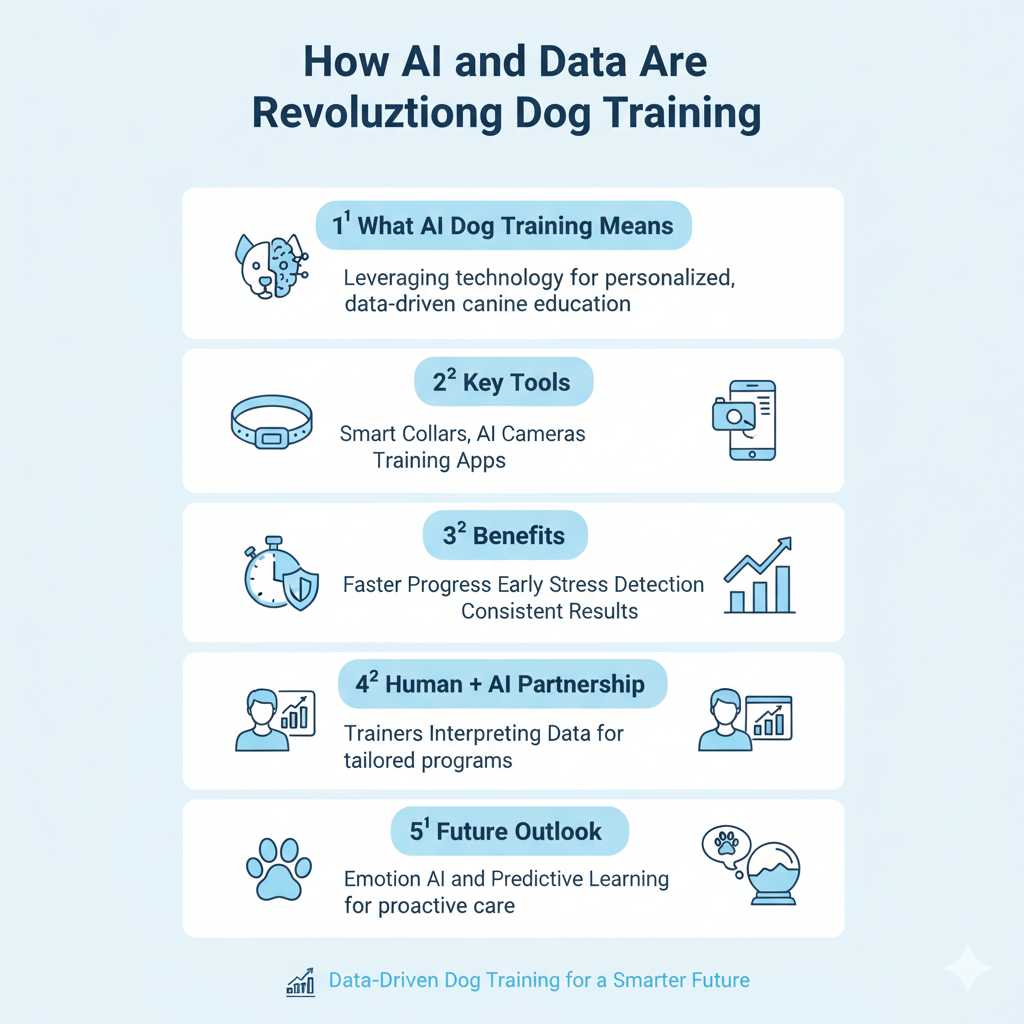
Introduction — When Dog Training Meets Technology
Just a decade ago, dog training was entirely human-led — relying on instinct, repetition, and observation. Today, AI and data analytics are changing that landscape.
Modern dog owners no longer want just basic obedience. They want faster progress, real-time feedback, and emotionally intelligent training that respects their dog’s individuality. That’s where artificial intelligence and behavioral data come in.
From smart collars tracking stress to AI-powered apps analyzing tail movement and vocal tone, technology is turning dog training into a data-informed partnership between people, pets, and precision tools.
This revolution is not about replacing trainers — it’s about enhancing their insight with measurable information that makes learning more personalized, efficient, and humane.
What Is AI-Driven Dog Training?
AI-driven dog training uses machine learning algorithms and behavioral analytics to assess, adapt, and guide obedience programs in real time.
Traditionally, trainers relied on experience and observation to interpret behavior. But now, AI tools collect continuous data — such as motion, heart rate, barking patterns, and environmental cues — to detect trends invisible to the human eye.
For instance:
A wearable device can alert a trainer when a dog’s stress levels rise.
Cameras with AI vision can detect posture and engagement during commands.
Apps can recommend adjustments based on how quickly a dog responds.
In short, AI enables training that’s not only personalized but predictive — capable of anticipating when a dog might lose focus or feel anxious before it even happens.
How Data Improves Behavior Analysis
The key to successful obedience is understanding why a dog behaves a certain way. Data makes that possible.
With AI-enabled sensors and trackers, trainers can now collect real-time insights into a dog’s habits, reactions, and routines.
Here’s how it works:
Motion sensors track walking pace and movement patterns — ideal for leash training.
Heart rate monitors measure excitement or stress responses during new tasks.
Microphone analysis identifies tonal changes in barks — distinguishing play from frustration.
Over time, AI models learn what’s normal for each dog and can alert trainers when behavior deviates — such as stress spikes in crowded areas or inconsistent responses to commands.
This allows proactive adjustments, ensuring the dog stays calm, engaged, and confident.
The Role of Machine Learning in Dog Obedience
Machine learning (ML) — the core of AI — improves with experience. The more data it receives, the better it understands patterns.
In training, this means AI can learn:
How quickly a dog grasps new cues
When they lose focus
Which rewards motivate them most
ML models analyze thousands of micro-interactions, giving trainers precise insight into when to repeat, pause, or progress lessons.
Over time, this creates data-informed routines where:
Commands are delivered at optimal timing
Reinforcement matches energy levels
Lessons evolve with the dog’s growth and maturity
It’s the perfect blend of science and sensitivity — training that evolves as intelligently as the dogs themselves.
Tools That Use AI in Dog Training (2025 Update)
AI is no longer futuristic — it’s already transforming homes and training schools across the U.S.
Here are some of the top categories reshaping obedience work:
1. Smart Collars
Modern collars track biometrics, sleep quality, activity, and emotional cues. They help trainers identify fatigue, overexcitement, or anxiety before it affects sessions.
2. AI Cameras
These analyze posture, focus, and gestures — giving visual feedback on whether a dog is confused, attentive, or distracted.
3. Adaptive Training Apps
Apps powered by AI recommend new lessons based on your dog’s progress. They act as virtual coaches, ensuring consistency between trainer and owner.
4. Voice Recognition Systems
Some devices can identify your tone, helping maintain consistent verbal cues — reducing confusion during multi-person training.
These tools ensure that every moment of practice contributes to a deeper understanding of your pet’s learning journey.
Personalized Training Through Predictive AI
Perhaps the most powerful application of AI is personalization — tailoring training plans to fit your dog’s unique learning style.
Predictive AI systems use data from wearables, video, and session tracking to determine:
How your dog responds to different types of reinforcement
When their focus is highest during the day
What environments trigger distraction or anxiety
By combining these insights, AI systems create dynamic training paths that adjust automatically based on performance.
For example, pet owners using personalized dog training programs in Tulsa now benefit from AI-enhanced progress tracking — ensuring every session aligns with their dog’s personality, learning speed, and emotional comfort.
This combination of human empathy and machine precision results in faster progress, calmer sessions, and happier pets.
Benefits of Data-Driven Dog Training
Data and AI aren’t just fancy add-ons — they provide tangible benefits for both trainers and owners.
1. Measurable Progress
AI tracking removes guesswork. You can visualize improvement through activity graphs, focus scores, and consistency ratings.
2. Early Stress Detection
AI monitors physical and behavioral signs to prevent overtraining or frustration — improving welfare and confidence.
3. Family-Wide Consistency
Data ensures all family members follow the same reinforcement patterns, avoiding mixed signals that confuse dogs.
4. Smarter Habit Formation
Algorithms predict when repetition will reinforce a behavior — helping owners practice just enough without burnout.
5. Long-Term Retention
AI ensures skills stick by spacing lessons strategically based on each dog’s memory pattern.
In short, data makes dog training smarter, safer, and more sustainable.
AI Doesn’t Replace Trainers — It Empowers Them
Some owners fear that technology could replace human trainers. But AI isn’t about automation — it’s about augmentation.
While AI can analyze behavior and suggest strategies, only a skilled human trainer can interpret emotional nuances and build empathy.
Think of AI as the “co-pilot.” It gathers evidence, spots patterns, and measures results, while trainers handle the emotional and relational side of learning.
In Tulsa, this hybrid approach is becoming a gold standard — combining precision data with compassionate guidance.
Real-Life Use Cases
Case 1: Reducing Reactivity
A rescue dog showing leash aggression was fitted with a smart collar. Data revealed stress spikes near other dogs but not people. The trainer adjusted distance thresholds and desensitization steps — reducing outbursts within 4 weeks.
Case 2: Improving Recall
An active retriever’s tracker showed peak responsiveness before noon. Training sessions were moved earlier, resulting in faster recall mastery.
These examples prove how data uncovers invisible factors, allowing fine-tuned interventions impossible with observation alone.
Local Perspective — How Tulsa Trainers Are Adopting AI Tools
Tulsa is becoming a hub for modern, data-driven obedience programs.
Local trainers are using AI wearables and apps to enhance:
Board train evaluations
Reactive dog behavior tracking
Custom lesson adjustments for family pets
The city’s blend of urban parks and suburban homes creates unique challenges — from leash reactivity to socialization issues. AI tools help Tulsa trainers adapt quickly, offering precision learning that keeps pace with each dog’s emotional and physical needs.
Ethical Considerations
As technology grows, ethics must follow. Trainers must ensure AI is used responsibly and transparently.
Key considerations include:
Data privacy: Owners must consent to data collection and know how it’s used.
Humane methods: AI should never encourage fear or punishment-based approaches.
Balanced reliance: Technology supports — but never replaces — empathy and positive reinforcement.
The best results happen when ethics and innovation evolve together.
The Future — Emotion AI and Beyond
The next frontier in training is Emotion AI — tools that interpret tail position, eye movement, vocal tone, and breathing patterns to understand how a dog feels in real time.
Imagine a trainer receiving instant alerts when a dog becomes anxious or disengaged — allowing immediate adjustments that protect emotional welfare.
In the near future, emotion-aware AI could:
Adjust reinforcement type based on mood
Identify frustration before vocalization
Adapt intensity dynamically during a session
It’s a world where obedience is no longer about control — but communication built on emotional awareness.
FAQs — AI in Dog Training
Q1. Can AI replace a professional trainer?
No. AI provides data and structure, but only human trainers understand emotion, tone, and trust-building.
Q2. Are AI-based tools accurate?
Yes, most modern devices have accuracy rates above 90% for tracking and analysis, but trainer interpretation remains essential.
Q3. Is AI training suitable for all breeds?
Absolutely. AI systems adapt to any dog’s pace and energy, making them great for puppies, rescues, or working breeds.
Q4. How does data collection affect privacy?
Responsible platforms store anonymized data and allow owners full control over sharing.
Q5. What kind of results can I expect?
Faster focus, reduced stress, and clearer communication — leading to consistent, confident obedience.
Conclusion — Smarter Training for Smarter Pets
The future of obedience isn’t about forcing compliance — it’s about understanding behavior through science.
AI and data bring transparency, precision, and adaptability to dog training, empowering owners and professionals to work smarter, not harder.
When combined with compassion and consistency, technology becomes a tool for deeper connection — helping every dog reach their full potential in a world that finally listens to their language.
The modern trainer isn’t just a teacher; they’re a translator between instinct and intelligence — and AI is helping them speak that language fluently.








